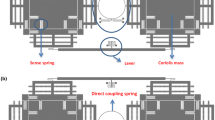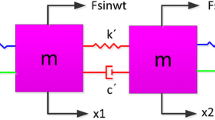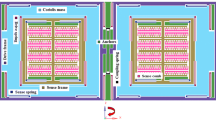Abstract
This paper has designed an anchor point lever beam coupled tuning fork micro-gyroscope and tested its output performance. The tuning fork micro-gyro is designed to eliminate the output error caused by orthogonal coupling and in-phase-inverting coupling by structural decoupling and electrical decoupling, and can improve the anti-vibration performance and the modal optimization ability. It has derived the dynamic response working model of the non-ideal tuning fork micro-gyroscope, and optimized the structural parameters of the micro-gyroscope by simulation analysis. The microstructure processing has been realized by the SOI-MEMS process, sealed the processed structural prototype, and tested the performance through the established experimental system. According to the test results, the designed micro-gyroscope driving direction has greatly reduced the in-phase-inverting coupling through the anchor coupling lever beam, and the detection direction effectively suppressed the in-phase-inverting coupling through the stiffness matching electrode. While closed-loop detecting, the measured Aallan variance zero-bias stability is 1.779°/h, and the 1σ zero-bias stability is 8.3°/h. While applying a stiffness matching voltage, the measured vibration sensitivity is 23.9°/h/g.














Similar content being viewed by others
Data Availability Statement
All data used to support the findings of this study are included within the article.
References
Soderkvist, J. (1994). Micromachined gyroscopes. Sensors and Actuators: A,43, 65–71.
Gao, Z. Y. (1995). Micromachined gyroscope principle and key technology. Journal of Instrumentation,16(4), 40–44.
Yazdi, N., Ayazi, F., & Najafi, K. (1998). Micromachined inertial sensors. Proceedings of the IEEE,86(8), 1640–1659.
Li, X. G., & Yuan, J. P. (2003). Development status of micromachined gyroscope. Progress in Mechanics,33(3), 289–300.
Cao, L., Li, Z., Guo, C., et al. (2019). Design and test of the MEMS coupled piezoelectric electromagnetic energy harvester. International Journal of Precision Engineering and Manufacturing,20(4), 673–686.
Song, B. Y., Xu, J. W., & Xu, L. (2019). Multilevel inverter fault diagnosis based on wavelet packet transform-principal component analysis-neural network algorithm. Journal of Shandong University of Science and Technology (Natural science edition),01, 111–120.
Liu, K., Zhang, W. P., Chen, W. Y., et al. (2009). The development of micro-gyroscope technology. Journal of Micromechanics and Microengineering,19, 1–28.
Xia, D. Z., Yu, C., & Kong, L. (2014). The development of micromachined gyroscope structure and circuitry technology. Sensors,14, 1394–1473.
Simon B. R. (2014). Mode ordering in anti-phase driven MEMS gyroscopes and accelerometers. America: University of California, Irvine.
Palaniapan, M., Howe, R. T., & Yasaitis, J. (2003). Performance comparison of integrated Z-axis frame gyroscope. In 16th IEEE international conference on micro electro mechanical systems (pp. 482–485). IEEE Press.
Ren, Y. S., Tian, J. S., Liu, Y. L., et al. (2019). Nonlinear deformation, thermal buckling and vibration of shape memory alloy fiber composite beams. Journal of Shandong University of Science and Technology (Natural science edition),1, 99–110.
Ni, Y. F., Li, H. S., Huang, L. B., et al. (2014). On bandwidth characteristics of tuning fork micro-gyroscope with mechanically coupled sense mode. Sensors,14, 13024–13045.
Yoon S. W., Lee, S. W., Perkins, N. C., et al. (2007). Vibration sensitivity of MEMS tuning fork gyroscopes. In IEEE sensors conference (pp. 115–118). IEEE Press.
Schofield, A. R., Trusov, A. A., & Shkel, A. A. (2007). Multi-degree of freedom tuning fork gyroscope demonstrating shock rejection. In IEEE sensors conference (pp. 120–123). IEEE Press.
Yoon, S. W., Lee, S., & Najafi, K. (2012). Vibration-induced errors in MEMS tuning fork gyroscopes. Sensors and Actuators: A,180, 32–44.
Walther, A., Blanc, C. L., Delorme, N., et al. (2013). Bias contributions in a MEMS tuning fork gyroscope. Journal of Microelectromechanical Systems,22(2), 303–308.
Cao, L., Zhang, Y., Sun, S-j, et al. (2018). Structure design and test of MEMS thermocouple infrared detector. Microsystem Technologies,24(5), 2463–2471.
Singh, T. P., Sugano, K., Tsuchiya, T., et al. (2012). Frequency response of in-plane coupled resonators for investigating the acceleration sensitivity of MEMS tuning fork gyroscopes. Microsystem Technologies,18(6), 797–803.
Singh, T. P., Sugano, K., Tsuchiya, T., et al. (2013). Experimental verification of frequency decoupling effect on acceleration sensitivity in tuning fork gyroscopes using in-plane coupled resonators. Microsystem Technologies,20(3), 403–411.
Chen, Y. (2004). Research on tuning fork micromachined gyro based on synovial damping effect. Shanghai: Shanghai Institute of Microsystem and Information Technology, Chinese Academy of Sciences.
Guo, Z. Y., Yang, Z. C., Zhao, Q. C., et al. (2010). A lateral-axis micromachined tuning fork gyroscope with torsional Z-sensing and electrostatic force-balanced driving. Journal of Micromechanics and Microengineering,20, 1–7.
Yin, Y., Wang, S. R., Wang, C. C., et al. (2008). Design and simulation of structure decoupling dual mass micro-gyroscope. Journal of Southeast University,38(5), 918–922.
Azgin, K., Temiz, Y., & Akin, T. (2007). An SOI-MEMS tuning fork gyroscope with linearly coupled drive mechanism. In Proceedings of the IEEE 20th international conference on micro electro mechanical systems (pp. 607–610). IEEE Press.
Simon, B. R, Trusov, A. A., Shkel, A. M. (2012). Anti-phase mode isolation in tuning-fork MEMS using a lever coupling design. In IEEE sensors conference (Vol. 3, No. 11, pp. 1–4). IEEE Press.
Acknowledgements
This work is supported by the funds of the the first batch of national virtual simulation experiment teaching project, China (No. 201806022) and overseas visiting project jointly sponsored by Shandong Province and Shandong University of Science and Technology.
Funding
This work is also supported by the funds of the overseas visiting project jointly sponsored by Shandong Province and Shandong University of Science and Technology.
Author information
Authors and Affiliations
Corresponding author
Additional information
Publisher's Note
Springer Nature remains neutral with regard to jurisdictional claims in published maps and institutional affiliations.
Rights and permissions
About this article
Cite this article
Cao, Lm., Li, Jw., Liu, Xw. et al. Research on an Anchor Point Lever Beam Coupling Type Tuning Fork Micro-gyroscope. Int. J. Precis. Eng. Manuf. 21, 1099–1111 (2020). https://doi.org/10.1007/s12541-020-00327-7
Received:
Revised:
Accepted:
Published:
Issue Date:
DOI: https://doi.org/10.1007/s12541-020-00327-7




